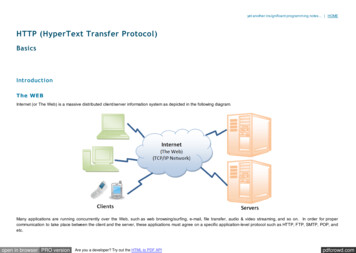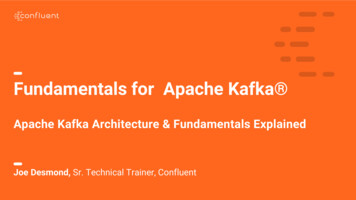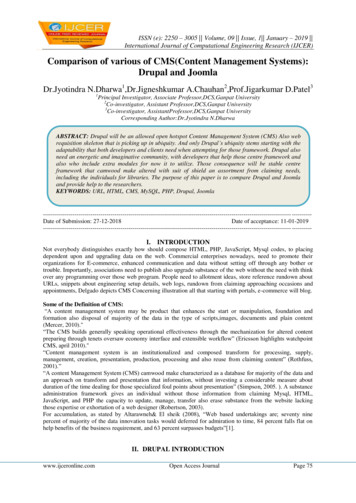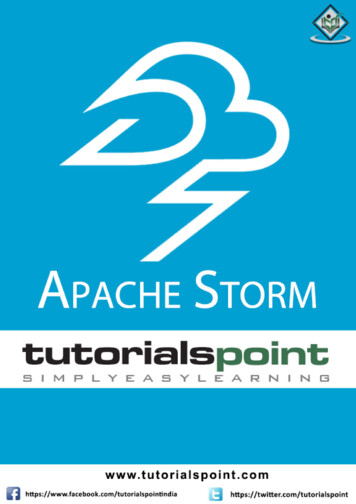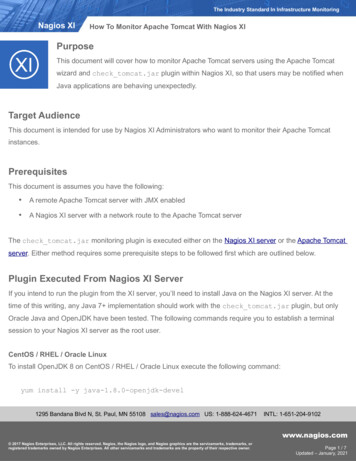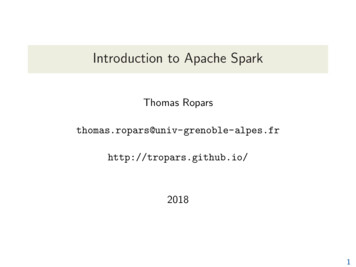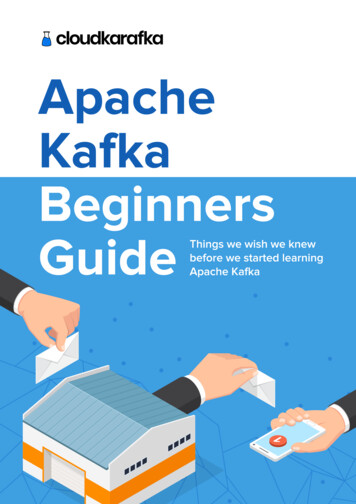
Transcription
Apache Wink Developer GuideThis page last changed on Apr 20, 2010 by shivakumar.Apache Wink 1.1Apache Wink is a complete Java based solution for implementing and consuming REST based WebServices. The goal of the Apache Wink framework is to provide a reusable and extendable set of classesand interfaces that will serve as a foundation on which a developer can efficiently construct applications.Contents1 Introduction to Apache Wink2 Apache Wink Building Blocks3 Getting Started with Apache Wink4 JAX-RS Concepts5 Apache Wink Server5.1 Registration and Configuration5.2 Annotations5.3 Resource Matching5.4 APP. Service Document5.5 Spring Integration5.6 WebDAV Extension5.7 Handler Chain5.8 Link Builder5.9 Assets5.10 Admin Views6 Apache Wink Client6.1 Getting Started with Apache Wink Client6.2 Configuring the Apache Wink Client6.3 Input and Output Stream Adapters7 Apache Wink Representations7.1 JsonDocument generated by Confluence on Apr 21, 2010 22:51Page 3
7.2 APP7.3 Atom7.4 RSS7.5 HTML7.6 CSV7.7 OpenSearch7.8 MultiPartAppendix A - Feeds SupportAppendix B - Google App EngineDocument generated by Confluence on Apr 21, 2010 22:51Page 4
1 Introduction to Apache WinkThis page last changed on Apr 20, 2010 by bluk.Introduction to Apache WinkApache Wink 1.1 is a complete Java based solution for implementing and consuming REST based WebServices. The goal of the Wink framework is to provide a reusable and extendable set of classes andinterfaces that will serve as a foundation on which a developer can efficiently construct applications.Wink consists of a Server module for developing REST services, and of a Client module for consumingREST services. It cleanly separates the low-level protocol aspects from the application aspects. Therefore,in order to implement and consume REST Web Services the developer only needs to focus on theapplication business logic and not on the low-level technical details.The Wink Developer Guide provides the developer with a rudimentary understanding of the Winkframework and the building blocks that comprise it.Welcome to Apache WinkWink is a framework for the simple implementation and consumption of REST web services. REST isan acronym that stands for REpresentational State Transfer. REST web services are "Resources" thatare identified by unique URIs. These resources are accessed and manipulated using a set of "Uniformmethods". Each resource has one or more "Representations" that are transferred between the client andthe service during a web service invocation.The central features that distinguish the REST architectural style from other network-based styles is itsemphasis on a uniform interface, multi representations and services introspection.Wink facilitates the development and consumption of REST web services by providing the means formodeling the service according to the REST architectural style. Wink provides the necessary infrastructurefor defining and implementing the resources, representations and uniform methods that comprise aservice.REST ArchitectureFor a detailed understanding of the REST architecture refer to the description by Roy Fielding inhis dissertation, The Design of Network-based Software Architectures. In particular, Chapter 5Representational State Transfer (REST) describes the principles of the architecture.REST Web ServiceFigure 1: REST Web service design structureDocument generated by Confluence on Apr 21, 2010 22:51Page 5
Figure 1 demonstrates the design principles and components that comprise a REST web service. Winkreflects these design principles in the implementation of web services.Apache Wink Open DevelopmentThe purpose of this document is to provide detailed information about Wink 1.1 and describe theadditional features that the Apache Wink 1.1 runtime provides in addition to the JAX-RS Java API forREST Web Service specification.In addition to the features description, this document also provides information regarding implementationspecific issues.This document provides the developer with a rudimentary understanding of the Wink 1.1 framework inorder to highlight the underlying concepts and precepts that make up the framework in order to create abasis for understanding, cooperation and open development of Wink.JAX-RS Specification DocumentFor more information on the JAX-RS functionality, refer to the JAX-RS specificationdocument, available at the following /final/jsr311/index.htmlJAX-RS CompliancyApache Wink 1.1 aims to be a fully compliant implementation of the JAX-RS v1.1 specification.JAX-RS is a Java based API for RESTful Web Services is a Java programming language API that providessupport in creating web services according to the Representational State Transfer (REST) architecturalstyle. JAX-RS uses annotations, introduced in Java SE 5, to simplify the development and deployment ofweb service clients and endpoints.Document generated by Confluence on Apr 21, 2010 22:51Page 6
2 Apache Wink Building BlocksThis page last changed on Apr 20, 2010 by bluk.Apache Wink Building BlocksIn order to take full advantage of Apache Wink, a basic understanding of the building blocks thatcomprise it and their functional integration is required. The following section provides an introduction tothe basic concepts and building blocks of Apache Wink. In order to gain in-depth understandings of thebuilding blocks refer to the table of contents where these concepts are expanded and addtional exampleare used to further illustrate the Apache Wink and JAX-RS SDK technologies.This section contains the following topics:Service Implementation Building Blocks ResourceProvidersURI DispatchingAssetsAnnotationsURL HandlingHTTP Methods - GET, POST, PUT, DELETE and OPTIONSBasic URL Query ParametersApache Wink Building Blocks SummaryClient Components Building Blocks RestClient ClassResource InterfaceClientRequest InterfaceClientResponse InterfaceClientConfig ClassClientHandler InterfaceInputStreamAdapter InterfaceOutputStreamAdapter InterfaceEntityType ClassThe Apache Wink Runtime Request Processor Deployment Configuration Handler ChainsService Implementation Building BlockOverviewAs mentioned in the "Apache Wink Introduction" section, Apache Wink reflects the design principlesof a REST web service. It does so by providing the developer with a set of java classes that enable theimplementation of "Resources", "Representations" and the association between them. Wink alsoenables the developer to define the resource URI and the "Uniform methods" that are applicable to theresource.Document generated by Confluence on Apr 21, 2010 22:51Page 7
ResourceA "resource" represents a serviceable component that enables for the retrieval and manipulation ofdata. A "resource class" is used to implement a resource by defining the "resource methods" thathandle requests by implementing the business logic. A resource is bound or anchored to a URI space byannotating the resource class with the @Path annotation.ProvidersA provider is a class that is annotated with the @Provider annotation and implements one or moreinterfaces defined by the JAX-RS specification. Providers are not bound to any specific resource. Theappropriate provider is automatically selected by the Apache Wink runtime according to the JAX-RSspecification. Apache Wink supplies many providers, however, application developers may supply theirown which take precedence over any provider in the default runtime.There are three types of providers defined by the JAX-RS specification: Entry Providers Context Providers Exception Mapping ProviderEntity ProviderAn "Entity Provider" is a class that converts server data into a specific format requested by the clientand/or converts a request transmitted by the client into server data. For instance, a String entityprovider can turn request entities (message bodies) over the wire into a Java type (java.lang.String).Entity providers can also turn native Java types such as a java.lang.String into an appropriateresponse entity. An entity provider can be restricted to support a limited set of media types using the@javax.ws.rs.Produces and @javax.ws.rs.Consumes annotations. An entity provider is configured tohandle a specific server data type by implementing the javax.ws.rs.ext.MessageBodyWriter and/orjavax.ws.rs.ext.MessageBodyReader interfaces.Figure 2: Entity Provider DiagramContext ProviderContext providers are used to supply contexts to resource classes and other providers by implementingthe javax.ws.rs.ext.ContextResolver interface. For example, if a custom JAXBContext is required toserialize or deserialize JAXB objects, an application can provide a ContextResolver that will return aspecific instance of a JAXBContext. Context providers may restrict the media types that they supportusing the @javax.ws.rs.Produces annotation.Figure 3: Context Provider DiagramDocument generated by Confluence on Apr 21, 2010 22:51Page 8
Exception Mapping ProviderException mapping providers map exceptions into an instance of a javax.ws.rs.core.Response byimplementing the javax.ws.rs.ext.ExceptionMapper interface. The Response objects can contain responseinformation such as status codes, HTTP headers, and a response entity (message body). When a resourcemethod throws an exception, the runtime will try to find a suitable ExceptionMapper to "translate" theexception to an appropriate Response object.Figure 4: Exception Mapping Provider DiagramURI DispatchingDesigning an efficient REST web service requires that the application developer understands theresources that comprise the service, how to best identify the resources, and how they relate to oneanother.RESTful resources are identified by URIs in most cases related resources have URIs that share commonpath elements.Figure 5: Apache Wink Logic FlowDocument generated by Confluence on Apr 21, 2010 22:51Page 9
Apache Wink Logic FlowFigure 5 illustrates the Apache Wink logic flow. The HTTP request sent by the client invokes the "ApacheWink REST Servlet". The REST servlet uses the "Request Processor" and the request URI in order tofind, match and invoke the correct resource method.Bookmarks ExampleThroughout this document, various project examples are used in order to describe the functionality andprocesses that comprise the Apache Wink.In order to explain the REST design principles used in the Apache Wink this developer guide refers to the"Bookmark" example project found in the examples folder located in the Apache Wink distribution.Refer to the code (using an IDE application) in the example in conjunction with the following explanationsand illustrations in this developer guide.Apache Wink Servlet and Request ProcessorFigure 6: Apache Wink REST Servlet and Request Processor for the Bookmark ServicesDocument generated by Confluence on Apr 21, 2010 22:51Page 10
Server and Request ProcessorFigure 6 shows the Apache Wink servlet and request Processor concept in the context of the applicationserver. In the "Bookmarks" example in Figure 6 there are two Resources, the first Resource is associatedwith the /mybookmarks URI and manages the bookmarks collection, the second resource is associatedwith the /mybookmarks/{bookmark} Resources and manages an individual bookmark within thecollection.The Resources' defined by the web service and managed by Apache Wink are referred to as "URIspace". The Resources space is the collection of all URI's that exist in the same context. Figure 6 showsthe URI space that contains /mybookmarks and /mybookmarks/{bookmarks}.URI SpaceThe Bookmarks service URI space consists of the following URI space items and detailed descriptionsabout their context and functionality.Table 1: URI ManagementURI space ItemDescription/Bookmark/restThis URI is the root context of the bookmarkservice and the entry point of the URI space of theservice. An HTTP GET request to this URI returnsa "Service Document" which is automaticallygenerated by Apache Wink. The service documentprovides information about all available collectionsin the URI space./Bookmark/rest /mybookmarksThis URI is associated with a collection ofbookmarks resources. Clients use the HTTP GETmethod in order to retrieve a representation ofDocument generated by Confluence on Apr 21, 2010 22:51Page 11
the collection and HTTP POST method in order tocreate a new item in the collection./Bookmark/rest /mybookmarks/{bookmark}This URI template is associated with a singlebookmark resource. Clients use the HTTP GETmethod in order to retrieve a representation ofthe resource, HTTP PUT method is used in order toupdate the resource and HTTP DELETE method isused in order to delete the resource.AssetsAssets are classes that contain "web service business logic" implemented by the developer. Each Assetis associated with one or more URI. The Apache Wink dispatcher invokes the Asset, which is associatedwith the URI found in the HTTP request.An Asset class can implement one or more methods, each method is associated with a single HTTPmethod (GET, HEAD, POST, PUT, DELETE etc). The methods can be associated with a MIME type of aproduced representation. Methods that handle HTTP verbs of requests with a body (such as PUT, POST)are also associated with the MIME type of the HTTP request.The Asset class can be registered to the Apache Wink using the "Spring context xml" or by using aregistration API.Spring Context ConfigurationFor further information regarding the Spring Context, refer to 5.5 Spring Integration insection 5 Apache Wink Server.AnnotationsAnnotations are a special text notations, or metadata, added to Java version 1.5. Annotations in Javasource code can affect both compilation and runtime behavior of the resulting Java classes.JAX-RS is implemented by the use of annotations that are defined in the JAX-RS specification. ApacheWink provides a set of additional annotations that enrich the functionality of the JAX-RS enabledapplication.The following table describes the additional Apache Wink eResourceAssociate a "CollectionResource" with a workspaceelement and collection elementsin an APP Service Document@ScopeResource /ProviderDefines the default lifecyclebehavior for resources andproviders, and the option forcontrolling the lifecycle throughthe ovides the ability to define abase template URI for the URIspecified in a resources @PathannotationDocument generated by Confluence on Apr 21, 2010 22:51Page 12
@AssetClassUsed by the Apache Winkruntime in order to identify anentity as an AssetURL HandlingThe Apache Wink receives HTTP requests and then dispatches a wrapped HTTP request to the appropriateResource method.The HTTP request is match to the Resource method based on the HTTP request parameters, the Resourcemethod definitions and the MIME type.Figure 7: URL Request HandlingRequest HandlingFigure 7 demonstrates the HTTP Client request path to the URI dispatcher, once the dispatcher receivesthe request it is then matched according to the HTTP method, URL and MIME type and finally theResource registry definition.HTTP Methods - GET, POST, PUT, DELETE and OPTIONSThe common HTTP 1.1 methods for the Apache Wink are defined in the following section. This set ofmethods can be expanded.Document generated by Confluence on Apr 21, 2010 22:51Page 13
Method UsageTable 3: HTTP UTXPOSTDELETE*XOPTIONSKey - X Safe - does not affect the server state Idempotent - a repeated application of the same method has the same effect as a singleapplication Cacheable - a response to a method is cacheable if it meets the requirements for HTTP caching * - Responses to this method are not cacheable, unless the response includes an appropriateCache-Control or Expires header fields. However, the 303 response can be used to direct the useragent to retrieve a cacheable resource.GETThe GET method is used to retrieve information from a specified URI and is assumed to be a safe andrepeatable operation by browsers, caches and other HTTP aware components. This means that theoperation must have no side effects and GET method requests can be re-issued.HEADThe HEAD method is the same as the GET method except for the fact that the HEAD does not containmessage body.POSTThe POST method is used for operations that have side effects and cannot be safely repeated. Forexample, transferring money from one bank account to another has side effects and should not berepeated without explicit approval by the user.The POST method submits data to be processed, for example, from an HTML form, to the identifiedresource. The data is included in the body of the request. This may result in the creation of a newresource or the updates of existing resources or both.PUTThe PUT method requests that the enclosed entity be stored under the supplied Request-URI. If theRequest-URI refers to an already existing resource, the enclosed entity should be considered as amodified version of the one residing on the origin server.If the Request-URI does not point to an existing resource, and that URI is capable of being defined as anew resource by the requesting user agent, the origin server can create the resource with that URI.Document generated by Confluence on Apr 21, 2010 22:51Page 14
DELETEThe DELETE method requests that the origin server delete the resource identified by the Request-URI.This method can be overridden on the origin server.The client cannot be guaranteed that the operation has been carried out, even if the status code returnedfrom the origin server indicates that the action has been completed successfully.OPTIONSThe OPTIONS method represents a request for information about the communication options available onthe request/response chain identified by the Request-URI.This method allows the client to determine the options and/or requirements associated with a resource,or the capabilities of a server, without implying a resource action or initiating a resource retrieval.Basic URL Query ParametersA URL parameter is a name and value pair appended to a URL. The parameter begins with a questionmark "?" and takes the form of name value.If more than one URL parameter exists, each parameter is separated by an ampersand "&" symbol. URLparameters enable the client to send data as part of the URL to the server.When a server receives a request and parameters are appended to the URL of the request, the serveruses these parameters as if they were sent as part of the request body. There are several predefinedURL parameters recognized by Apache Wink when using Wink providers. The following table lists theparameters commonly used in web service URLs. These special URL parameters are defined in the"RestConstants" class.Query ParametersTable 4: URL ParametersParameterDescriptionValuealtProvides an alternativerepresentation of thespecified MIME type. ApacheWink recognizes this as arepresentation request of thehighest priority.MIME type, e.g."text%2Fplain"absolute-urlsIndicates to Apache Wink thatthe generated links in theresponse should be absolute,mutual exclusive with therelative-urls parameterNONErelative-urlsIndicates to Apache Wink thatthe generated links in theresponse should be relative,mutual exclusive with theabsolute-urls parameterNONEcallbackWrap javascript representationin callback function, is relevantwhen requested with anapplication/json MIME type.name of callback function.For example, "myfunc"Combining URL ParametersA single URL can contain more than one URL parameter, example "?alt text%2Fjavascript&callback myfunc"(where "%2F" represents escaped "/").Document generated by Confluence on Apr 21, 2010 22:51Page 15
Apache Wink Building Blocks SummaryThe previous section "Service Implementation Building Blocks" outlines the basic precepts andbuilding blocks that comprise the service side of Apache Wink.In order to understand the relationship between the building blocks that comprise Apache Wink a set ofexample applications have been designed and built that provide a reference point that demonstrate arudimentary understanding about the functionality of Apache Wink.Apache Wink ExamplesThe following examples applications are used in this "Apache Wink Developer Guide". Bookmarks HelloWorld QADefectsBookmarks ProjectThis developer guide uses the bookmarks example application in order to describe the logic flow processwithin Apache Wink.Refer to the comments located in the "Bookmarks" example application code for in-depth explanationsabout the methods used to build the bookmarks application.HelloWorld ProjectComplete the step-by-step "HelloWorld" tutorial in chapter 3 "Getting Started with Apache Wink"and then follow the installation instructions on page xx, in order to view the "Bookmarks" exampleapplication from within the Eclipse IDE.QADefectsThe QADefects example application illustrates the advanced functionality of Apache Wink byimplementing most of the features provided by the Apache Wink (Runtime) framework.Apache Wink Client Component BasicsOverviewThe Apache Wink Client interacts with REST Web-Services. It maps REST concepts to Java classes andencapsulates underlying REST related standards and protocols, as well as providing a plug-in mechanismfor raw HTTP streaming data manipulation. This mechanism also provides the ability to embed crossapplication functionality on the client side, such as security, compression and caching.Figure 8: Apache Wink Client Simplified BreakdownDocument generated by Confluence on Apr 21, 2010 22:51Page 16
Figure 8: The illustration shows the basic elements that comprise the Apache Wink Client. The ApacheWink Client utilizes the providers mechanism defined by the JAX-RS specification to perform readingand writing of java objects. The Apache Wink Client is pre-initialized with the same providers that arepredefined by the Apache Wink JAX-RS server implementation.Apache Wink Client ComponentsThe Apache Wink Client is comprised of several key elements that together create a simple andconvenient framework for the consumption of REST based web services. The client is an abstraction ofREST concepts modeled into simple java classes that encapsulate the underlying HTTP protocol, used forthe service invocation.The Apache Wink Client uses the java HttpURLConnection class for the HTTP invocation. The ApacheWink Client also provides a module that utilizes the Apache HTTP Client instead of the defaultHttpURLConnection class.The following section provides an overview of the key elements and classes that comprise the ApacheWink Client.RestClient ClassThe RestClient class is the central access point to Apache Wink Client. It provides the user withfunctionality that enables the creation of new Resource instances. The RestClient provides the user withthe ability to set different configuration parameters and custom JAX-RS providers and propagates them tothe created resources.Resource InterfaceThe Resource interface represents a single web resource located at a specific URL, enabling for themanipulation and retrieval of the resource by the invocation of different HTTP methods on the resourceinstance. The resource interface is implemented following the Builder design pattern so method calls canbe easily aggregated and in order to enable easy construction of requests and setting of the resourceproperties prior to invocation.ClientRequest InterfaceThe ClientRequest interface represents a request issued by invoking any one of the invocation methodson a Resource. An instance of a ClientRequest is created at the beginning of an invocation and passed toall the client handlers defined on the client that was used for the invocation.Document generated by Confluence on Apr 21, 2010 22:51Page 17
ClientResponse InterfaceThe ClientResponse interface represents an HTTP response that is received after invoking any one of theinvocation methods on a Resource. An instance of a ClientResponse is created by the ConnectionHandlerat the end of the handler chain, and is returned from every handler on the chain.ClientConfig ClassThe ClientConfig class provides client configuration when instantiating a new RestClient. The ClientConfigis implemented using the Builder design pattern so method calls can be easily aggregated. CustomProviders and client Handlers are set on the ClientConfig instance prior to the creation of the RestClient.ClientHandler InterfaceClient handlers are used to incorporate cross invocation functionality. The ClientHandler interface isimplemented by client handlers, and the handle() method is invoked for every request invocation in orderto allow the handler to perform custom actions during the request invocation.InputStreamAdapter InterfaceThe InputStreamAdapter interface is used to wrap the response input stream with another input streamin order to allow the manipulation of the response entity stream. The adapt() method is called afterreading the response status code and response headers, and before returning to the ClientResponse tothe handlers on the chain.OutputStreamAdapter InterfaceThe OutputStreamAdapter interface is used to wrap the request output stream with another outputstream to allow the manipulation of the request entity stream. The adapt() method is called beforewriting the request headers to allow the adapter to manipulate the request.EntityType ClassThe EntityType is used to specify the class type and the generic type of responses. Typically, ananonymous "EntityType" instance is created in order to specify the response type, as is shown in thefollowing code example:Resource resource client.resource(uri);List String list resource.get(new EntityType List String () {});ApacheHttpClientConfig ClassThe "ApacheHttpClientConfig" Configuration object configures the Apache Wink Client to use theApache HttpClient as the underlying HTTP client. The following code snippet, demonstrates the typicalusage:// creates the client that uses Apache DefaultHttpClient as the underlying Http client.RestClient client new RestClient(new ApacheHttpClientConfig(new DefaultHttpClient()));// creates the resourceResource resource client.resource("http://myhost:80/my/service");// invokes a GET method on the resource and receives the response entity as a stringString entity resource.get(String.class);Document generated by Confluence on Apr 21, 2010 22:51Page 18
.The Apache Wink RuntimeThe Apache Wink runtime is deployed on a JEE environment and is configured by defining the RestServletin the web.xml file of the application. This servlet is the entry point of all the HTTP requests targeted forweb services, and passes the request and response instances to the Wink engine for processing.Figure 9: Apache Wink Request Processor ArchitectureThe diagram illustrates the core components of the Apache Wink runtime. The Wink engine is theRequestProcessor. It builds an instance of a MessageContext with all of the required information for therequest and passes it through the engine handler chains. The handler chains are responsible for servingthe request, invoking the required resource method and finally generating a response.In case of an error, the RequestProcessor invokes the Error chain with the generated exception forproducing the appropriate response.The Apache Wink runtime maintains providers and resources in two registries, the "providers registry"and the "resource registry" utilizing them during request processing.Request ProcessorThe RequestProcessor is the Apache Wink engine, that is initialized by the RestServlet and is populatedwith an instance of a DeploymentConfiguration.When a request is passed to the handleRequest() method of the RequestProcessor, a new instance of aMessageContext is created.The MessageContext contains all of the information that is required for the Wink runtime to handle therequest. The RequestProcessor first invokes the Request Handler Chain and then the Response HandlerChain.If an exception occurs during any stage of the request processing, the RequestProcessor invokes the ErrorHandler Chain for processing the exception.Document generated by Confluence on Apr 21, 2010 22:51Page 19
Deployment ConfigurationThe Apache Wink runtime is initialized with an instance of a Deployment Configuration. The DeploymentConfiguration holds the runtime configuration, including the handler chains, registries, configurationproperties.The Deployment Configuration is initialized with an instance of a JAX-RS Application used for obtaininguser resources and providers.Customization of the Handlers ChainThe handler chain is customized by extending the org.apache.wink.server.handlers.HandlersFactory class,overriding specific methods and specifying the new class in the web.xml file of the application.In order to specify a different HandlersFactory class instead of the default handlers, specify aninit parameter for a custom properties file to be loaded by the RestServlet. Then, the value of thewink.handlersFactoryClass property must be set as the fully qualified name of the customized handlersclass in the properties file. servlet servlet-name restSdkService /servlet-name servlet-class t /servlet-class init-param param-name propertiesLocation /param-name param-value path/to/my-wink-properties.properties /param-value /init-param /servlet In the my-wink-properties properties file:wink.handlersFactoryClass org.apache.wink.MyCustomHandlersFactorySee the JavaDoc for the HandlersFactory API.Handler ChainsThe handler chain pattern is used by the Wink runtime for implementing the core functionalities.There are three handler chains utilized by the Wink runtime: RequestHandlersChain ResponseHandlersChain ErrorHandlersChainHandler ChainsFor further information regarding the "Handler Chains", refer to section 5 Apache WinkServer, 5.7 Handler Chain - Runtime ExtensionDocument gener
5.5 Spring Integration 5.6 WebDAV Extension 5.7 Handler Chain 5.8 Link Builder 5.9 Assets 5.10 Admin Views 6 Apache Wink Client . Wink is a framework for the simple implementation and consumption of REST web services. REST is an acronym that stands for REpresentational State Transfer. REST web services are "Resources" that



